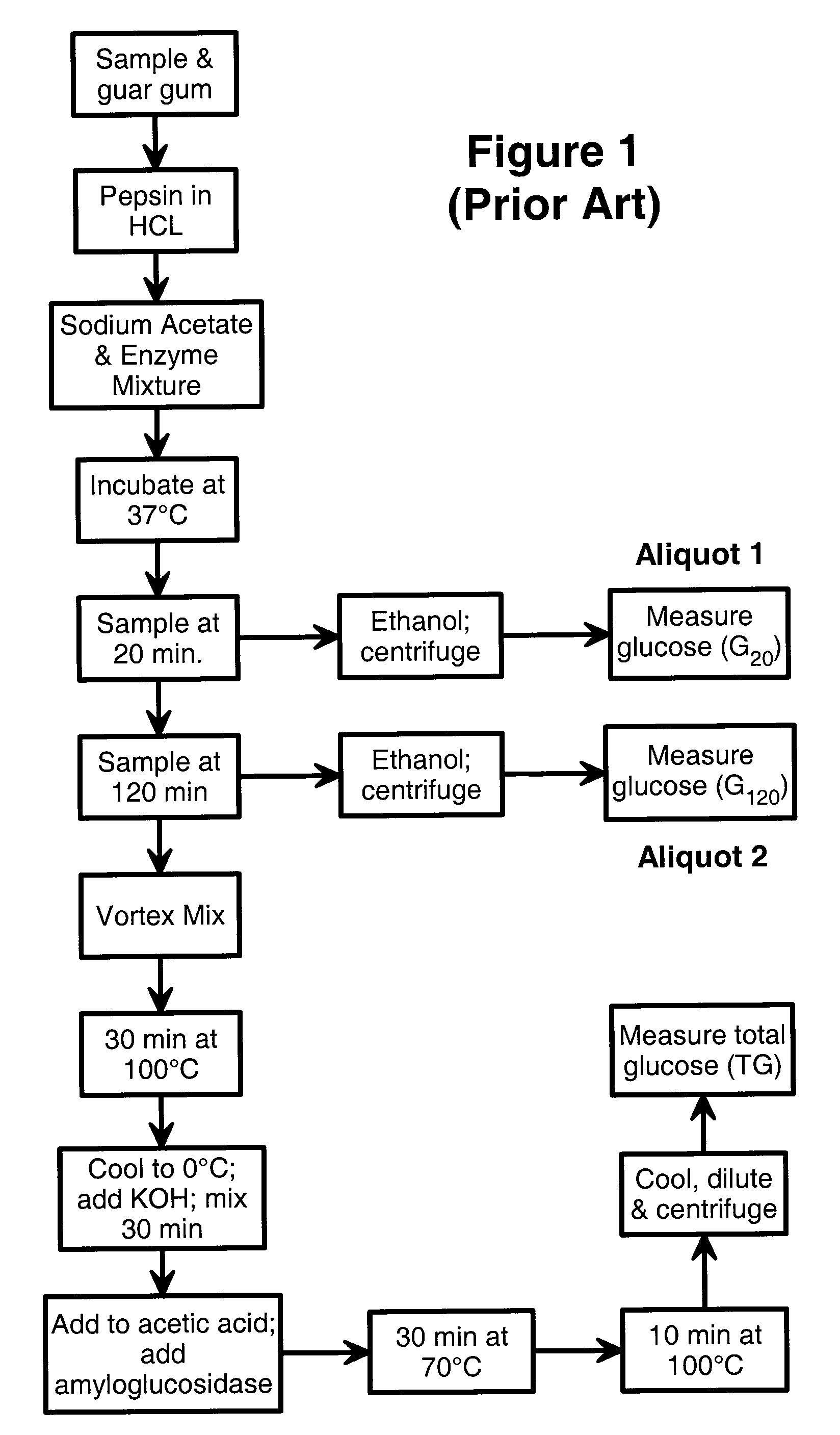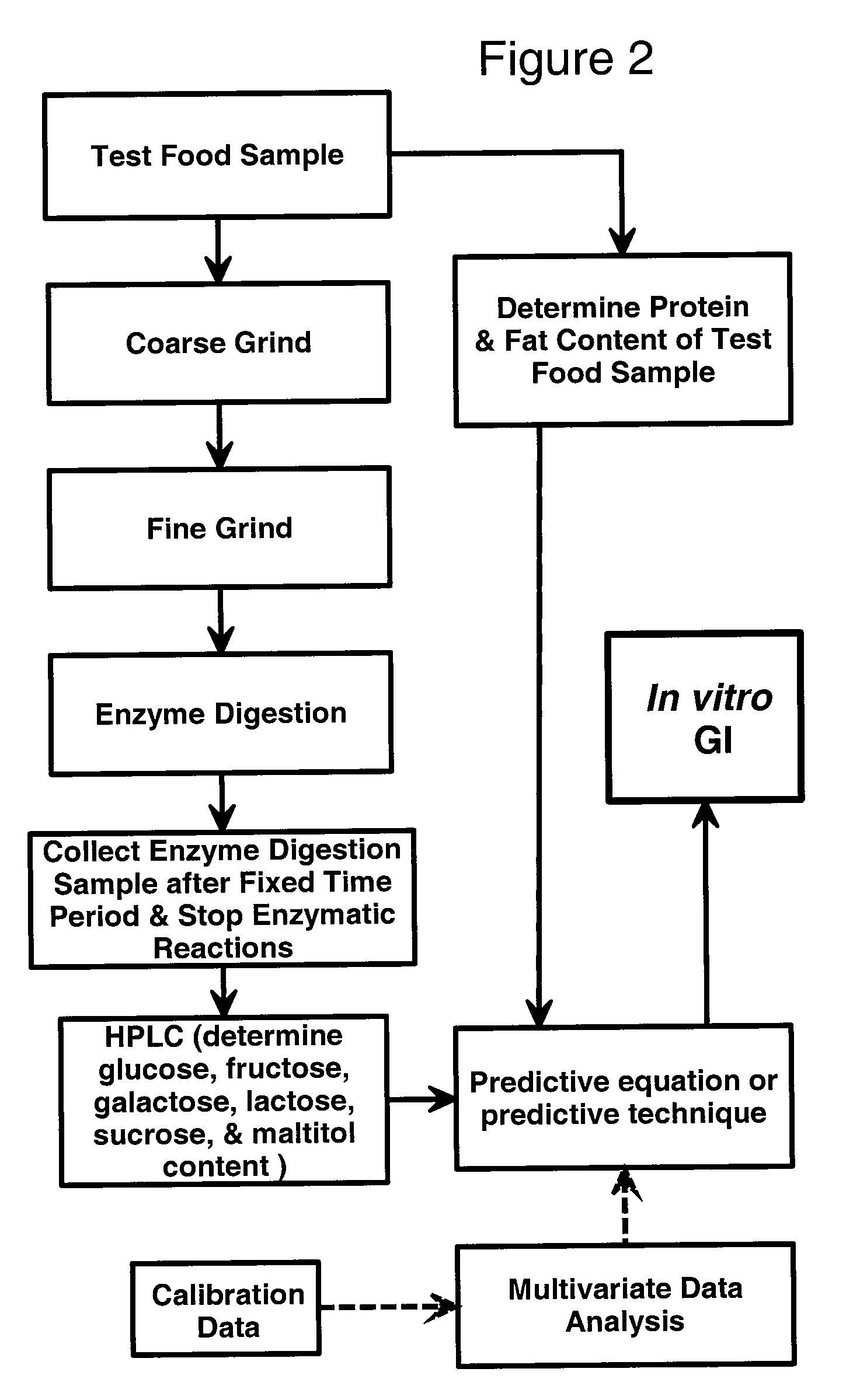In vitro Method for the Determination of Glycemic Index of Food Products
- Summary
- Abstract
- Description
- Claims
- Application Information
AI Technical Summary
Benefits of technology
Problems solved by technology
Method used
Image
Examples
example 1
[0068]This Example provides a detailed analytical protocol for carrying out the in vitro glycemic index determination of the present invention for both the calibration of the method and determination of unknown samples. In all cases where specific equipment, reagents, and / or specific procedures and operating parameters are suggested, it will be understood that equivalent equipment, reagents, and / or specific procedures and operating parameters can be used.
[0069]Apparatus:
[0070]1. Temperature-controlled shaking water bath (capable of about 175 strokes / min);
[0071]2. Vortex mixer;
[0072]3. Analytical balance (accurate to within ±0.0001 g);
[0073]4. Volumetric flasks, Class A, 100 ml, 1000 ml;
[0074]5. Pipets, Class A, 1 ml, 2 ml, 5 ml, 6 ml, 10 ml;
[0075]6. Glass balls, 6 mm (Fisher #11-312-D or equivalent);
[0076]7. Glass sample vials (40 ml) with screw caps (VWR #66014-389 or equivalent);
[0077]8. Plastic centrifuge tubes (50 ml) with screw caps (VWR #21008-730 or equivalent);
[0078]9. Centr...
example 2
[0158]A large number of commercially available food products and other food samples were examined using both in vivo and in vitro test protocols. Most (25 out of a total of 34) in vivo glycemic index values were determined using in vivo tests conducted by a well-known, well-respected private testing lab experienced in such testing; the remainder of such in vivo glycemic index values were taken from the scientific literature. These same samples were also examined using the in vitro method of the present invention as described in Example 1. These data were then used to calculate model parameters for the in vitro glycemic index test described herein using the MLR, PLS, and neural net methods available in JMP Statistical Software.
[0159]After the parent application was filed, it was discovered that the HCl solution used to prepare the Pepsin / Guar Gum Solution was 0.5 N rather than the desired 0.05 N. Since the Pepsin / Guar Gum Solution is used to prepare the enzyme digestion solution, the...
example 3
[0168]After filing the original application, work was continued and additional data points have been added and certain modifications made to the method to provide an even more accurate and precise in vitro method. As noted in Example 2 above, the pH during the enzyme digestion step in Example 2 was too low. The proper pH value for the enzyme digestion step should be about 5; other than that modification, the samples were treated in the same manner as in Example 2. Thus, 31 of the samples used in Example 2 were rerun to obtain data at the more optimal enzyme digestion pH. Additionally, 34 new samples have been added to the rerun sample from Example 2 to bring the total number of samples to 65. This in vitro method (current as of the date of this continuation-in-part application) is based on samples enzyme digested at the more optimal pH value and is presented herein. Of course, as one skilled in the art realizes, the accuracy and precision of this method is also likely to be increase...
PUM
 Login to View More
Login to View More Abstract
Description
Claims
Application Information
 Login to View More
Login to View More - R&D
- Intellectual Property
- Life Sciences
- Materials
- Tech Scout
- Unparalleled Data Quality
- Higher Quality Content
- 60% Fewer Hallucinations
Browse by: Latest US Patents, China's latest patents, Technical Efficacy Thesaurus, Application Domain, Technology Topic, Popular Technical Reports.
© 2025 PatSnap. All rights reserved.Legal|Privacy policy|Modern Slavery Act Transparency Statement|Sitemap|About US| Contact US: help@patsnap.com



